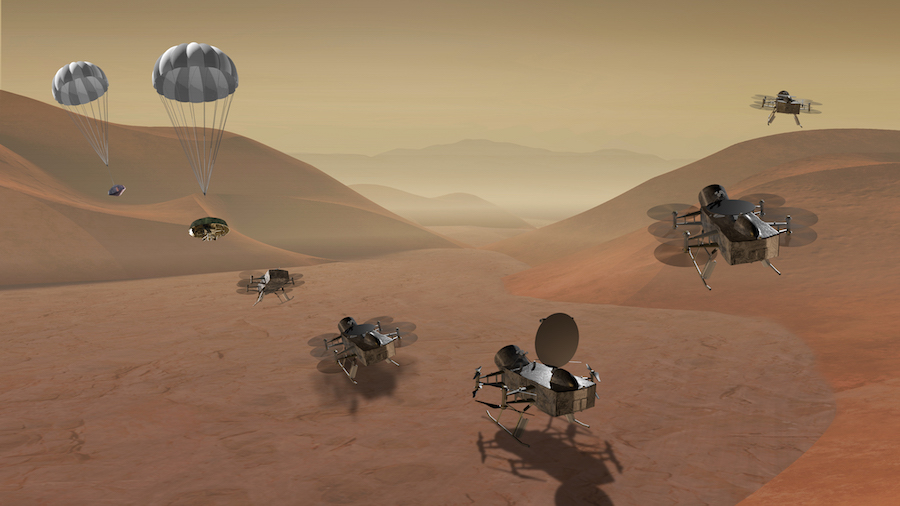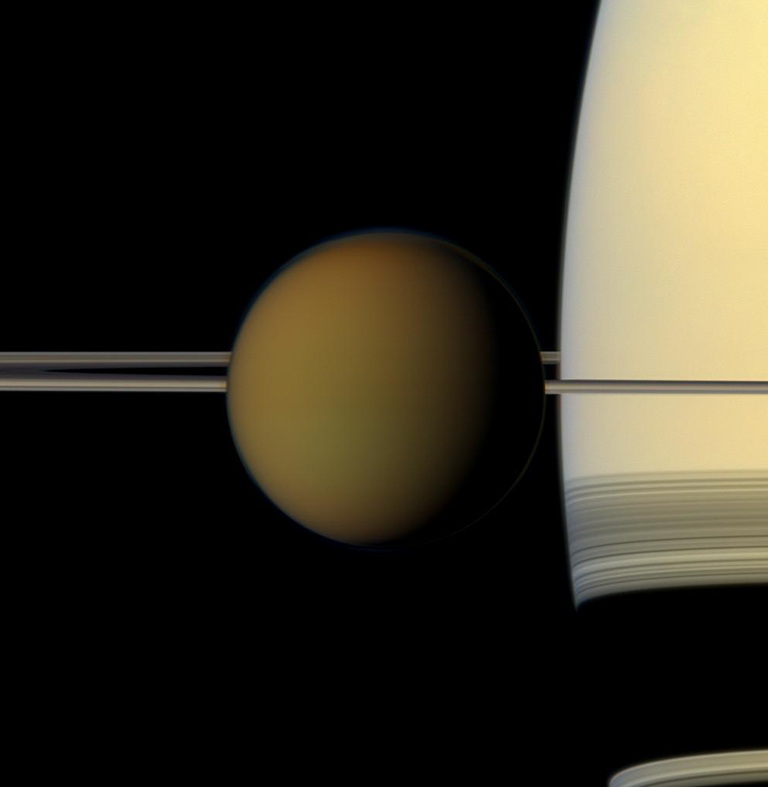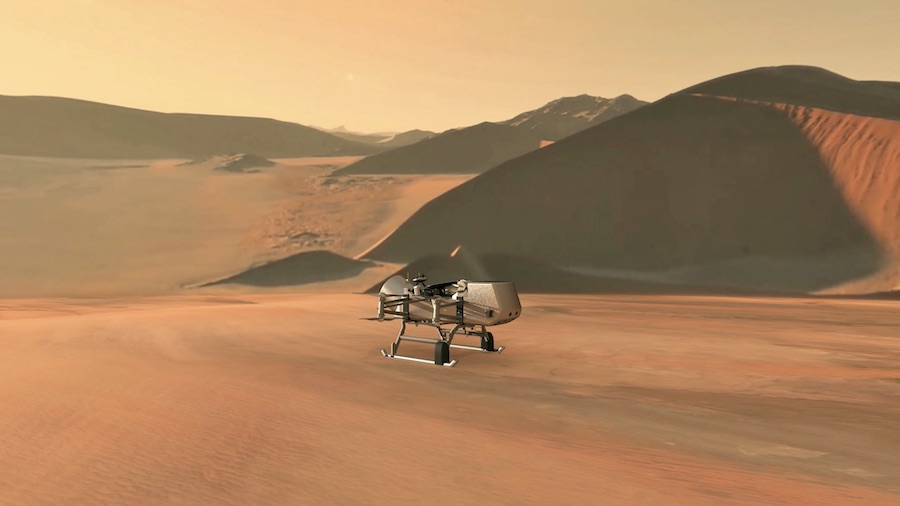
NASA officials announced Thursday that the agency will move forward with the development of a plutonium-powered robotic quadcopter drone to explore Saturn’s moon Titan, a hazy world covered with dunes and methane lakes that scientists say is reminiscent of the ancient Earth.
The Dragonfly mission will launch in 2026 and reach Titan in 2034, descend through its thick atmosphere and deploy a rotorcraft to make multiple hops across the moon’s alien surface over a 2.7-year mission, surveying dune fields and craters.
“Titan is a very Earth-like place, despite the fact that the materials are very different at this very low temperature, and the bedrock is water ice and the sand dunes are made of organic sand grains, and the liquid on the surface is liquid methane,” said Elizabeth Turtle, principal investigator for the Dragonfly mission at the Johns Hopkins University Applied Physics Laboratory.”
Most of what scientists know about Titan came from NASA’s Cassini spacecraft and a European Space Agency probe named Huygens, which made the first landing on Saturn’s largest moon in 2005.
Cassini made 127 flybys of Titan in its 13-year tour of Saturn before its mission ended in September 2017, unveiling the moon’s surface for the first time to see lakes of methane with rugged shorelines, streams and sand dunes. NASA’s Voyager probes could not see through Titan’s hazy veneer when they flew by Saturn in 1980 and 1981.
“One of the great things about Dragonfly is with the cameras it has looking forward and downward, as Dragonfly is flying over the surface, it’s going to be taking pictures and sending them back to Earth,” said Curt Niebur, lead program scientist for NASA’s line of New Frontiers missions. “So we will actually get the experience of flying along with Dragonfly, looking down at this alien, yet very familiar kind of surface that has these rivers and mountains.
“I think that’s going to be a tremendous experience for the public, and I think everybody’s really going to enjoy it,” Niebur said.

Titan’s thick atmosphere makes getting down to the ground tricky, but once there, Titan’s soupy atmosphere will make for an excellent flying environment, scientists said.
“Flying on Titan is actually easier than flying on Earth,” Turtle said. “The atmosphere is four times denser, at the surface, than the atmosphere at the surface of Earth, and (Titan’s) gravity is about a seventh of the gravity here on Earth. So it’s actually easier to fly on Titan. If you put on wings, you’d be able to fly on Titan.”
Cassini discovered weather systems on Titan, including rain storms and winds that appear to generate waves in the methane lakes.
“You get the rain coming down, collecting into really larger lakes, the size of Earth’s Great Lakes, filled to great depth with all this liquid methane. and it really creates a kind of weather cycle, just like we have on Earth, just without the liquid water,” Niebur said.
But many questions about Titan remain unanswered. It’s the solar system’s only moon with a dense atmosphere — made primarily of nitrogen — but Titan’s orange haze hides its surface from conventional cameras. Cassini peered through the atmosphere with an imaging radar to reveal huge land masses, oceans and other surface features.
The temperature at Titan’s surface hovers around minus 300 degrees Fahrenheit (minus 184 degrees Celsius), much too cold for liquid water at the surface. But there is evidence that Titan harbors an underground ocean of liquid water.
The Dragonfly drone will carry cameras, drills, seismic and weather sensors, and spectrometers to examine the composition of Titan’s rocks and soil, collecting four basic types of measurements. Vacuum-like suction devices on the craft’s landing skids will suck up surface material for analysis in an on-board miniature oven, which will sense any organic compounds or biosignatures in the soil.
A plutonium power source, known as a Multi-Mission Radioisotope Thermoelectric Generator, or MMRTG, will charge the craft’s battery to power the instruments, eight electrically-driven rotors and a high-gain antenna to beam data directly to Earth.
“What really excites me about this mission is the fact that Titan has all of the key ingredients needed for life,” said Thomas Zurbuchen, head of NASA’s science mission directorate. “Liquid water and liquid methane, we have complex organic carbon-based molecules, and we have the energy that we know is required for life.
“So we have, on Titan, an opportunity to observe the processes that were present on early Earth, when life began to form, and possibly even conditions that may harbor life today,” Zurbuchen said. “We may be able to look for biosignatures there today.”
Dragonfly’s mobility will allow it to travel up to 110 miles (180 kilometers) across Titan over the course of 20 or more hops.
About the size of a Mars rover, the flying drone will allow scientists to explore a wider range on Titan than a mission restricted to the surface. Dragonfly will first touch down in Titan’s equatorial dune fields, then travel to a crater to investigate a region where remote sensing observations from Cassini suggest the presence of water ice outcrops.
And unlike a rover on the surface, an instrumented drone will not be stopped or delayed by obstacles like rocks and steep slopes.
NASA selected Dragonfly over a competing proposal named the Comet Astrobiology Exploration Sample Return, or CAESAR, mission to become the fourth mission in the agency’s New Frontiers program. CAESAR would have flown a spacecraft to Comet 67P/Churyumov-Gerasimenko, the same comet first explored by Europe’s Rosetta mission, and collected a sample from its nucleus for return to Earth.
The three previous New Frontiers missions developed by NASA are all currently operating in space.
The New Horizons spacecraft launched in 2006 and conducted the first up-close flyby of Pluto in 2015, then continued farther into the outer solar system to encounter a 22-mile-long (35-kilometer) world in the Kuiper Belt named Ultima Thule on Jan. 1.
NASA’s Juno orbiter launched in 2011 and arrived at Jupiter in 2016 to study the giant planet’s atmosphere and magnetosphere, and the OSIRIX-Rex mission lifted off in 2016 and reached the asteroid Bennu late last year, where the spacecraft will retrieve a sample for return to Earth.
Agency officials announced Dragonfly and CAESAR as finalists from an initial list of 12 mission proposals for the fourth New Frontiers mission in December 2017. NASA is committing up to $850 million to design and develop the Dragonfly mission, excluding launch and operations costs.
When those expenses are fully accounted, the mission is expected to cost around $1 billion.

“Dragonfly will be the first drone lander with the capability to fly over 100 miles through Titan’s thick atmosphere,” said NASA Administrator Jim Bridenstine. “Titan is unlike any other place in our solar system, and the most comparable to early Earth.
“This revolutionary mission would have been unthinkable just a few short years ago,” Bridenstine said. “A great nation does great things. We will launch Dragonfly to explore the frontiers of human knowledge for the benefit of all humanity.”
But Dragonfly is a risky mission.
“This mission is bold,” Zurbuchen said. “We do these bold missions that change not only what we know, but how we think what’s possible that we can do.”
Dragonfly will be built and managed at APL, which oversaw the development of the New Horizons probe and NASA’s Parker Solar Probe, which launched last year and has already set a record for the closest spacecraft to the sun.
“When we got the proposal for this mission, the first proposal, the science was so compelling that we looked at all the risks that were there — and there were quite a number of them — and we just basically said we want to give them a chance,” Zurbuchen said.
In a conference call with reporters Thursday, NASA officials discussed several of the early risks they identified early with the Dragonfly concept, such as the potential for hydrocarbons to clog the probe’s science instruments.
“Titan is rich in hydrocarbons,” Niebur said. “Usually, when we have a NASA mission, we are struggling to find trace amounts of these things, and Titan has so many that the concern was raised that that vacuum cleaner system that sucks up the sample and deliver it to the instrument could get clogged or contaminated.”
The Dragonfly team redesigned the sample delivery system over the last year-and-a-half, during a preliminary “Phase A” study funded by NASA.
“All these risks, 10 risks or so, that were there were eliminated,” Zurbuchen said. “So it’s a team that has proven itself, a team that’s highly diverse in all dimensions, and therefore innovative, and brought together by a strong principal investigator.”
“One of the things about Dragonfly that is not necessarily apparent at first sight is that, while this is a new way of exploring a different planet, this is actually technology that is very mature on Earth,” Turtle said. “There’s so much technology development in terms of rotorcraft here on Earth, in terms of autonomous flight, and indeed a lot of the instrumentation that we will fly on Dragonfly is based on instrumentation that is sitting on the surface of Mars right now, that has flown in space before. So really what we’re doing with Dragonfly is innovation not invention.”
Turtle’s team originally proposed launching Dragonfly in 2025, but NASA is giving the mission an extra year to prepare for launch.
“We felt at NASA … that the team could benefit greatly by some additional time to work through some of the challenges,” said Lori Glaze, head of NASA’s planetary science division. “There was a very tight schedule, and we thought having a little extra time would help with that.”
The original Dragonfly trajectory featured a flyby of Earth in 2026, one year after its launch in 2025, followed by further gravity assist flybys with Venus and Earth to slingshot toward Saturn, targeting a direct entry into Titan’s atmosphere in 2034.
With a launch in 2026, engineers have deleted the first Earth flyby from the trajectory, and Dragonfly will still reach Titan in 2034.
The spacecraft will plunge into Titan’s atmosphere for a two-hour descent, using friction and a parachute to slow down before the rotorcraft releases from its aeroshell and flies itself to the surface, landing directly on its skids.
Dragonfly’s exploration will be limited to the equatorial regions of Titan, away from its methane oceans. The northern hemisphere, where Titan’s largest seas are located, will be in winter when the spacecraft arrives, with the sun and Earth below the horizon.
“The big question that remains about the materials on the surface of Titan is the composition of the solid materials,” Turtle said.
The Cassini spacecraft’s radar was able to resolve Titan’s methane seas and identify their chemical composition.
“The big outstanding question is what the nature of these solid surface materials are, and that’s where the keys to understanding the prebiotic chemistry that is so abundant on Titan lies, in the solid surface materials,” Turtle said.
Email the author.
Follow Stephen Clark on Twitter: @StephenClark1.